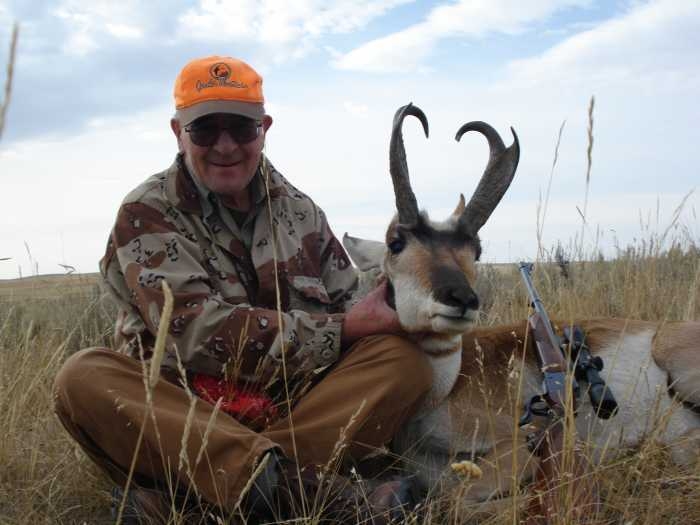Hunting antelope during the rut in Wyoming
There is nothing better than watching two buck antelope going at it in the middle of the rut. It’s one of the most intense battles you’ll see in the wild. Pound for pound I don’t think there is another animal on this earth that is as aggressive as a buck antelope.
The rut starts in at the end of August and ends at the end of September. Starting at the end of August, the Alpha bucks will begin to gather does up to put into their harem. If an inferior buck comes into his area he will be met by the Alpha buck. Sometimes a short fight will pursue but at this time of year the inferior will typically flee to safer ground.
Antelope bucks make scrapes to warn others not to come into their territory. I’ve not been able to tie a pattern to these scrapes. It seems that the scrapes are random. The bucks will urinate and sometimes defecate in the scrape and rub to mark their area. They will also rub a gland underneath their jaw on sage. The does don’t use these rubs to find a mature buck.
The weather will affect the rut. Sometimes it will last for five weeks and on drier years it will last for a couple of weeks. In our area, the rut usually runs from the second to third week of September. In 2012, which was a dry year, the rut only lasted a week and it started at the end of the third week into the fourth week. I think this is the best time to bow hunt for trophy antelope. During this time you can use decoys and calls to drag a trophy antelope within bow range.
When I was growing up you could start hunting at the age of 14. I had been shooting a bow for three years and could hardly wait to go hunt for something larger than a rabbit. Mel Dutton, designer of Dutton Decoys, had come to our ranch with a group of bow hunters that had been coming out since the early 1970’s. Mel left one of his decoys at the ranch after making a film to promote his product.
I rode the bus home from school and had been paying attention to the antelope on the way home. I noticed a buck chasing another on the way home. That was it! As soon as the bus stopped, I jumped off of the bus, ran in the house change into camouflage and grabbed my bow and decoy.
I had watched a trophy antelope buck in a pasture located north of my Uncle Gus’s house. My father drove me up the county road and dropped me off so that I could get to a vantage point. I picked up my glasses and began to scan the terrain. There he was! He was in a drainage with his harem of twelve to fifteen does. I was in a position to sneak within 500 yards of him. I crawled as close as I could and quite frankly was tired of dragging the bow and decoy along across the ground.
It was a hot and dry summer and the ground was as hard as a rock. The decoy was designed with a stake that was intended to be shoved into the ground to keep it upright, giving the hunter a chance to draw and shoot the bow. The buck was chasing a doe back into the herd when I got into position. I lifted the decoy up and tried to shove the stake into the ground. I weighed 103 pounds that year but I don’t think it would have mattered if I would’ve weighed 250 pounds. There was no way that stake was going to shove into the dry soil. At that point I decided the best option was to lean the decoy against my shoulder.
Due to my experience, lack of it, I had been so focused on the decoy, I hadn’t knocked an arrow. I peeked over the top of the decoy at this point and my heart began racing. The buck was on a dead run coming right at me! My eyes were locked on the buck and I reached down feeling for the arrows in the quiver. I pulled an arrow out and at that point the buck seemed to be less than seventy yards and closing fast. With the bow in my left hand a freshly drawn arrow in my right. I began to bring the arrow over the top of the bow and at this point the buck was twenty yards away. That’s when I heard a strange POW. The buck was at ten yards now! I looked down and I had cut the bow string with my broad head! My heart sunk. There was nothing I could do at this point and the buck was intent on running the decoy out of the area. I pushed the decoy forward and threw the arrow at the buck. The buck spooked and I sat there on the prairie with a broken heart and cut bow string.
This hunt happened during the peak of the rut. This part of the rut is exhausting for a trophy buck. He has two jobs during this time. Take the care of his harem by defending it form other bucks and breeding the does that come into heat. Their focus is locked on these two issues and consequently become vulnerable to hunters.
During the last part of the rut most of the does that have come into cycle are now roaming freely. Some does will come in during the second cycle. At this point the previous territories have no bearing on the harem or the bucks. You’ll often see young bucks breeding these second cycle does. This phase last until the herd gathers for the winter.
By October, the rut is over. In our area, this is rifle season. The rut is hard on a trophy antelope. Due to all of the fighting most of the time a trophy buck may not be a trophy. A lot of times they will break their cutters or the tips of their horns off.
I hope this article has helped you understand the three major phases of the antelope rut. The main reason for writing this article is to show the significant differences between the deer rut and antelope. I’m often asked how the antelope rut compares to whitetail deer because a lot of our clients are from whitetail country. The main difference I’ve noted, talking with whitetail hunters, is with antelope there is no rhyme or reason to their scrapes. But like whitetail deer the best time to hunt a trophy is during the rut.




